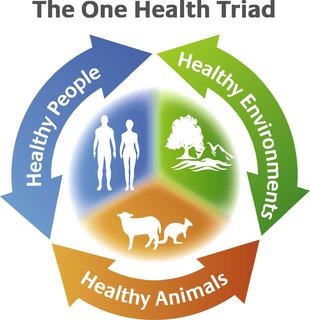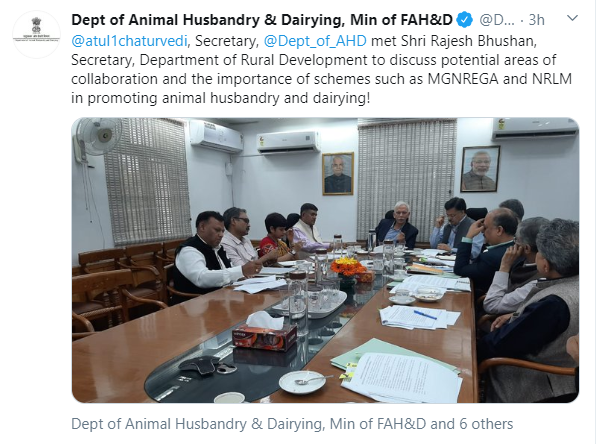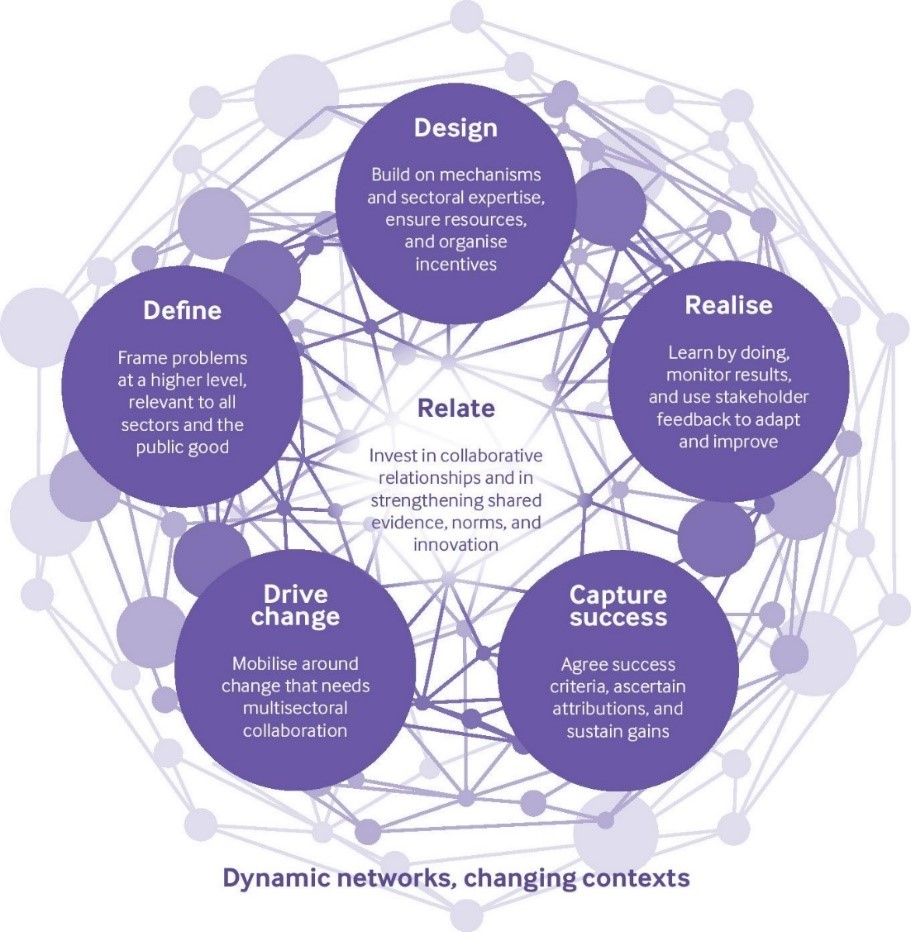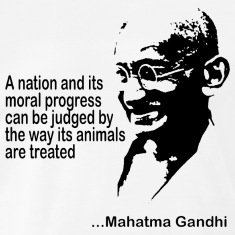
Inter-departmental collaboration amongst the government line departments is essential for the convergence of development schemes. Convergence brings synergies between different government programs/schemes in terms of planning, process, and execution often leading to innovation. Collaboration in any form is directly related to the achievement of the Sustainable Development Goals. Additionally, such collaboration is also vital for Animal Husbandry and Veterinary Departments in the context of ‘One Health.’ One Health’ is the collaborative effort of multiple disciplines — working locally, nationally, and globally to attain optimal health for people, animals, and the environment (1).

The ‘One Health Triad’ Source: R.C.A. Thompson, International Journal for Parasitology 43 (2013) 1079–1088
The government of India has recognized the importance of convergence. There are instances of focused efforts aimed at the promotion of convergence, e.g., Between Mahatma Gandhi National Rural Employment Guarantee Scheme (2) and other government schemes and programs to enable better planning and productive investment in rural areas.
As far as the promotion of the ‘One Health’ approach is concerned, India is investing in institutional arrangements such as the Integrated Disease Surveillance Program (IDSP) under the Ministry of Health and Family Welfare. The Biodiversity and Health program under the forthcoming “The National Mission on Biodiversity and Human Well-Being” will look into two aspects of how biodiversity can improve healthcare. In essence, one will create an interactive citizen’s portal on medicinal plants of India to provide reliable information for managing human, livestock, and crop health. The second aspect will investigate the relationships between biodiversity loss and patterns of infectious diseases that spread to humans from animals (3)
Recently, as part of the emergency lending fund for India, under the COVID-19 Emergency Response and Health Systems Preparedness Project, World Bank (4) has sanctioned USD 100Mn for the Department of Animal Husbandry and Dairying (DAHD). The DAHD is planning to establish a National Animal Disease Control Centre in coordination with the National Center for Disease Control. It will help in the detection and prevention of emerging animal diseases, with a focus on zoonotic diseases.
Concurrent to initiatives at the level of Central Government, State Government departments should work jointly with state-level planning related institutions who are already mandated with the task of faciliting leadership development for convergence in development program implementation and promotion of the ‘One Health’ concept. The State Animal Husbandry and Veterinary Departments (SAHVD) should thrive for achieving collaboration with the Department of Agriculture, Health, Food Safety, Forestry, and Environment. There are also ample opportunity for collaboration of SAHVD with various other institutions such as instituions promoting cooperative formation, banking and insurance products, export promotion etc. The following can be a few potential areas for discussion before the partnering departments can finalize any agreements of collaboration in broader areas of Agriculture, Environment, Health, Rural development etc. The suggestions related to topics of discussion are not exhaustive and will depend on the specific context and administrative structure of each state. SAHVD’s can also plan to choose limited areas at a time and work towards designing collaborative projects.
Areas of discussion with the Agriculture department
- Ways to improved state-level crop planning to ensure availability of feed and fodder for livestock
- Enhanced sharing of data on feed crop production, e.g., maize and availability of agricultural biomass for animal use
- Integration of information related to care and management of livestock while publishing the agricultural crop calendar
- Joint inspection and maintenance of agricultural marketing facilities where livestock and livestock products are also traded
- Promotion of the use of cow dung and poultry manure as fertilizer and remunerative prices for the same for livestock and poultry farmers
- Scope of joint organization of extension, skill development, and consumer awareness camps
- Orientation and capacity building of Village Level Agricultural Extension Workers (VLEWs) in the field of livestock and poultry farming and veterinary public health.
- Sharing of data on agriculturally less productive areas and joint promotion of livestock ownership to support family income in such areas.
- Scope of collaboration for farmer or farm premise identification, disaster planning, and promotion of organics
- Joint use of facilities, institutional structures, the convergence of schemes to enhance field data generation, farmer outreach, and targeted delivery of farmer level benefits for synergy
Areas of discussion with the Environment and Forest department:
Many Indian states are known for their biodiversity and natural resources, including wildlife. The majority of protected areas under forest departments are known to have a vast population of forest-dependent poor and excluded people in fringe areas. Many of these people rear livestock. Public health and conservation threat arising out of emerging animal diseases should, therefore, a priority area. The agreement of cooperation with forest and environment department should create scope for:
- Joint registration of farm families in forest fringe villages and collaboration for targeted preventive veterinary care and support for stall feeding of domestic livestock. (to minimize open grazing)
- Joint declaration of guidelines for vaccination by Non-Government Organizations (NGOs) in forest fringe villages.
- Joint initiative on wildlife disease monitoring and appropriate integration of the same to domestic animal health and human health surveillance in forest fringe areas
- Collaboration for resource sharing for joint work in zoo management, wildlife health care, rescue, translocation, and rehabilitation efforts.
- The mechanism to share information regarding observed ecosystem alternations and other related aspects for integrated disease risk assessment
- Collaborative work on human-animal conflict resolution.
- Joint declaration of guideline for sustainable use of natural resources and in reducing pollution from institutions related to veterinary services, farms, hatcheries, etc
- Cooperation for rejuvenation of grassland, fodder production through agroforestry and aggregation of forest biomass
- Plantation of fodder tree under social forestry.
- Cooperation in the development of agri-tourism related to traditional livestock-related practices
Areas of discussion with the Department of Health and Food safety
In the majority of states, a strategic understanding and an institutional mechanism of collaboration through the state unit of the Integrated Disease Surveillance Program (IDSP) under the aegis of the National Centre for Disease Control (NCDC) is already in place. The State Veterinary Department will have to strengthen the collaboration for joint disease investigation besides rapid response of public health linked disease-related emergencies and data gathering on zoonotic diseases.
Separate understanding may be required with the Office of the Commissioner of Food Safety to conduct a risk assessment of livestock-based products and to undertake joint regulatory activities for the prevention of livestock product adulteration.
Areas of discussion with the Panchayat and Rural Development Department
The Animal Husbandry and Veterinary Department in all states share the maximum opportunity for convergence of development programs with the State Rural Development Department and its sister project-based agencies. The collaboration should start with formal involvement in the preparation of village and district development plans. The Animal Husbandry and Veterinary Department essentially need to assist panchayats in listing beneficial and local need-based animal husbandry linked interventions. Administratively, the subject of veterinary and animal husbandry in many states is devolved to panchayats (the Local self-government). A more active partnership of the Department with panchayats will help in improving access to veterinary services. The Department of Animal Husbandry and Dairying of Government of India in recent times has taken the initiative to work jointly with the rural development department.

Tweet indicating efforts at collaboration between the Department of Animal Husbandry and Dairying and Department of Rural Development
Some crucial areas of discussion can be:
- Geotagging and sharing of information thereof regarding animal husbandry and veterinary-related infrastructures/assets created at the village level under various programs of the rural development department.
- Selection, training, and deployment of the workforce of appropriately certified animal health workers under the supervision of veterinarians. ( Upskilling of existing community workers such as pashusakhis, gopal mitra’s to address the adequacy of veterinary service delivery ensuring public health )
- Support of panchayats for implementation of Department development schemes and national programs such as the National Animal Disease Control Program (NADCP) and Nationwide Artificial Insemination Program (NAIP).
- Support of panchayats for regular monitoring and evaluation of departmental programs
Areas of discussion with the State Disaster Management Authority:
State Veterinary Department maintains a disaster response plan. Regular review of the planned activities and the preparedness requires that the Department maintains coordination with the State Disaster Management Authority. The following can be some of the discussion areas:
- Sharing of information on Village Grazing Reserve (VGR) and joint verification of the same for status and green coverage.
- GIS-based mapping of departmental facilities
- Identification of high land in the flood-prone area for construction of raised shelter/platform for livestock
SAHVDs in many states are struggling to achieve even intradepartmental collaboration. It is a tough challenge for change leaders to achieve the goal of attaining cooperation with other line departments. Any collaborative agreement with other line departments must lead to viable projects and programs. Much effort is also needed to sustain collaborative projects. The following is a model suggested by Kuruvilla Shyama et al. (2018), indicating the enabling factors for effective multisectoral collaboration (5). The learning from this can be of immediate reference for leaders within State Animal Husbandry and Veterinary Departments.

The model suggested by Kuruvilla Shyama et al. (2018), indicating the enabling factors for effective multisectoral collaboration
Drive change: set agendas and mobilize a critical mass of stakeholders for change, ascertain whether the situation is best tackled by multisectoral collaboration, and optimize linkages across sectors and SDGs.
Define: clarify the situation in a way that improves how problems are assessed, and enables stakeholders to agree on a course of action and develop a well-defined project.
Design: build on existing mechanisms and sectoral expertise to plan programs, set up governance for the multisectoral collaboration, and develop innovations that are relevant to stakeholders, contexts, and goals
Realize: strengthen implementation, monitoring, and evaluation as iterative and adaptive processes that facilitate learning from successes and failures, and adapt to change.
Relate: Systematically assess and strengthen synergies between sectors, manage multisectoral collaborations, and promote multi-stakeholder dialogue and deliberation.
Capture success: use a range of qualitative and quantitative methods to monitor and evaluate results comprehensively and promote learning from both successes and failures, and formulate multisectoral collaboration as an intervention to which health and development outcomes can be attributed.
Reference:
(1) As suggested by The American Veterinary Medical Association
(2) Mahatma Gandhi National Rural Employment Guarantee Scheme: A scheme with an objective of enhancing livelihood security in rural areas of India by providing at least 100 days of guaranteed wage employment in a financial year, to every household whose adult members volunteer to do unskilled manual work.
(3) The National Mission on Biodiversity and Human Well-Being
(4) COVID-19 Emergency Response and Health Systems Preparedness Project
(5) Kuruvilla Shyama, Hinton Rachael, Boerma Ties, Bunney Ryan, Casamitjana Nuria, Cortez Rafael et al. Business not as usual: how multisectoral collaboration can promote transformative change for health and sustainable development BMJ 2018; 363:k4771 Click Here
(Prepared based on the recommendation of Assam Vet Roadmap Report-2018 of Department of Animal Husbandry & Veterinary, Government of Assam prepared by Vet Helpline India Pvt Ltd.
For more information on the project, please visit: Assam Vet Roadmap Project Page
Citation:
Barbaruah Miftahul et al, Promoting inter-departmental collaboration in State Animal Husbandry and Veterinary Departments in India, The Vet Helpline E-magazine, Category: Livestock Policy, Planning, and Projects, Vol VIII (2020) ISSN 2454-9282





